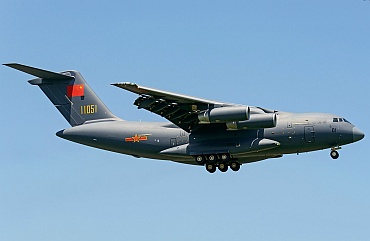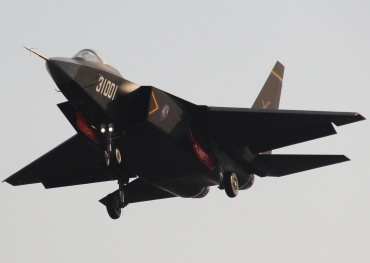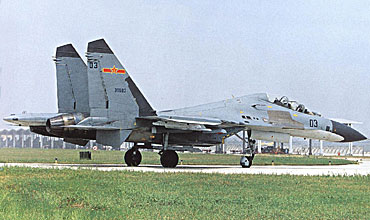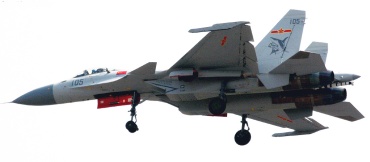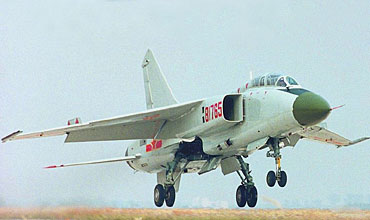| type |
first flight |
number build |
remarks |
J-5 versions |
| J-5 |
歼5 |
19jul56 |
767 |
Imported MiG-17 and also licence build MiG-17F, including 15 MiG-17F knock down kits and ten build from Russian parts. Initial designation DongFeng 101 (东风101). Initially also known as Zhong 101 and type 56. Total 767 includes all Cinese build J-5 and J-5A. |
| J-5A |
歼5甲 |
1964 |
|
MiG-17PM derivative. |
| J-5C |
|
|
|
drone conversion of J-5. |
J-6 versions |
| J-6 versions |
歼6 |
1961-1986 |
3000 |
MiG-19S/P/PM derivatives. |
| DongFeng 102 |
东风102 /
59式 |
23sep59 |
1 |
J6 proto based on MiG-19PF and MiG-19SF
Build by Shenyang. Also known as Type 59. |
| J-6A |
歼6甲 |
17dec58 |
|
MiG-19P derivative by Shenyang. Limited all-weather version.
Initial designation DongFeng 103 (东风103). Also known as Type 59A.
From 1974 examples were modified to cater PL-2/K-13 missile launches. |
| J-6B |
歼6乙 |
24feb59 |
|
MiG-19PM derivative by Nanchang. All-weather version.
Initial designation DongFeng 105 (东风105). Also known as Type 59B.
Saw very limited service due to low quality. |
| J-6 / F-6 |
歼6 |
1961 |
|
Revised production model based on MiG-19S nose (no radar) and armament and MiG-19P tail (two intakes).
Optionally with inboard or outboard hardpoints on wing. |
| J-6C |
歼6C |
|
|
Late J-6 version (MiG-19S/P) with drag chute in tail.
Believed to be non-official designation. |
| J-6I |
歼6丙 / 歼6I |
1966 |
|
High-altitude day interceptor, with radar on engine-inlet splitter plate.
Increased wing chord and no cannons. |
| J-6II |
歼6Ⅱ |
25mar69 |
|
Improved J-6I version with two 30mm cannons but no guns. |
| J-6III |
歼6Ⅲ |
05aug69 |
|
Improved J-6II version with three 30mm cannons and movable intake centerbody. |
| J-6IV |
歼6IV |
1970 |
7 |
Unsuccessful all-weather J6III version by Shenyang with two wing-root mounted cannons. |
| J-6IIIC |
|
|
|
Unsuccessful all-weather J6III version by Guizhou. |
| J-6Xin |
|
|
|
J-6IV and J-6IIIC after rebuild to airworthy condition. |
| J-6W |
|
2006 |
~200 |
Drone conversion for deep penetration bombing missions. |
Dong Feng projects |
| DongFeng 104(1) |
东风104 (1) |
|
0 |
Shenyang project cancelled in 1958. |
| DongFeng 107 |
东风107 |
|
0 |
Shenyang project cancelled in 1958. High-speed fighter. |
| DongFeng 113 |
东风113 |
|
0 |
Harbin project cancelled 1958, Single-engine, high-speed fighter. |
Chengdu (CAC) J-7 versions (MiG-21F-13 derivatives) |
| J7 |
歼7 |
17jan66 |
12 |
License build MiG-21F-13. Prototypes only. Also known as Type 62. Build by Shenyang that also assembled 25 MiG-21F-13 kits. |
| J-7I / F-7A |
歼7I |
jun76 |
188 |
Production version of J-7 with unsatisfactory quality. Canopy opens forward. Small numbers exported as F-7A. Build until 1981 |
| J-7II / F-7B |
歼7Ⅱ / 歼7B |
30dec78 |
475 |
Improved J-7I version with improved engine, larger drop-tanks and rear-hinged canopy.
Build between 1979-1986 at CAC (375) and Guizhou (about 100). |
| F-7BS |
|
|
|
Simplified F-7B for Sri Lanka. |
| J-7IIA |
歼7ⅡA |
mar84 |
|
Improved J-7II with communication antenna on top of fin and pitot-tube re-located from beneath engine inlet to above-right position. |
| J-7IIH/J-7H |
歼7ⅡH/歼7H |
mar85 |
221 |
Improved J-7II able to fire two PL8 missiles instead of PL5.
Build between 1986-1993 |
| J-7IIK/J-7K |
歼7ⅡK/歼7K |
1990 |
59 |
Upgraded J-7II with new avionics. |
F-7M
"Airguard" |
歼7M "空中卫士" |
31aug83 |
|
Much improved J-7IIA, westernized avionics in export version. used by Bangladesh, Iran, Myanmar and Zimbabwe. |
| F-7MG (1) |
|
|
1 |
Modernized F-7M. CAC demonstrator. Straight wing. |
| F-7PG (1) |
歼7PG |
9jun88 |
1 |
Modernized F-7M. CAC demonstrator. Straight wing. |
| F-7P "Airbolt" |
歼7P
"天空闪电" |
|
|
Improved F-7M version for Pakistan. |
| F-7MP "Airbolt" |
歼7MP |
1988 |
140 |
Modernized (engine, cockpit, avionics) F-7P for Pakistan. |
| J-7 target |
歼7靶 |
|
|
Drone conversions of the J-7II. |
Chengdu/Guizhou J-7 versions (MiG-21MF derivatives) |
| J-7C |
歼7C |
26apr84 |
17 |
Reverse engineered Egyptian AF MiG-21MF with WS13 engine. Previously called J-7III (歼7Ⅲ).
Build between 1988-1996 |
| J-7D |
歼7D |
1994 |
32 |
Improved J-7C version (engine, radar, cockpit). Previously called J7IIIA.
Build until 1999. |
Chengdu (CAC) J-7E versions (third generation J-7) |
| J-7E |
歼7E |
may90 |
205 |
Third generation J-7 based on J-7II airframe with double-delta wing. Previously called J-7IV (歼7IV).
In production until 2002. |
| J-7EB |
歼7EB |
|
24 |
Modified J-7E used by "1st August" / "Ba Yi" demonstration team until 2005. |
| J-7EH |
歼7EH |
|
34 |
J-7E version used by Navy. |
| J-7FS |
歼7FS |
8jun98 |
1 |
Technology demonstrator with J-7E proto airframe (in itself former F-7M proto) and chin type engine inlet. |
| F-7MG (2) |
歼7MG |
|
5+ |
CAC demonstrator for J-7E export. Double delta wing. |
| F-7PG (2) |
歼7PG |
|
51 |
F-7MG version for Pakistan, with (a.o.) single-peace windshield.
Delivered between 2000 and 2003. |
| J-7G |
歼7G |
June 2002 |
80+ |
Domestic version based on F-7PG succeeding J7E production. |
| J-7GB |
歼7GB |
dec04 |
12 |
Modified, unarmed J-7G ersion used by "1st August" / "Ba Yi" demonstration team between 2005 and 2009. |
| J-7L |
歼7L |
|
|
J-7E updated with many J-7G features, especially the fire control radar. |
| F-7BG |
|
2006 |
12 |
Export J-7G for Bangladesh |
| F-7NG |
|
2006 |
12 |
Export J-7G for Nigeria in 2006. |
| F-7NM |
|
2008 |
6 |
Export J-7G for Namibia. |
| F-7BGI |
|
2012 |
12 |
Improved F-7BG for Bangladesh |
J-8 "Finback" versions |
| J-8 |
歼8 |
5jul69 |
80 |
Day-fighter by Shenyang (SAC) with pitot type engine inlet. Production started only in 1980. Forward opening cockpit. |
| J-8A |
歼8A |
24apr81 |
3 proto's + ~100 |
All-weather fighter (J8 upgrade) with ranging radar (and aft opening cockpit). Previously called J-8I (歼8I). |
| J-8ACT |
歼8ACT |
|
1 |
Based on J-8I. ACT: Active Control Technology. |
| J-8E |
歼8E |
|
|
Converted J-8As with new fire control radar and avionics. Long unpainted engine exhaust. |
| J-8B "Finback" versions |
| J-8B |
歼8B-01 |
12jun84 |
|
Improved J-8A with lateral engine inlets (early designation J-8II - 歼8Ⅱ). |
| J-8B block 2 |
歼8B-02 |
|
|
Improved J-8B (fire control radar, cockpit, avionics). Early designation J-8IIB. |
| J-8IIACT |
歼8ⅡACT |
1988 |
1 |
Canard equipped fly-by-wire testbed based on J-8B. Also known as BW-2. |
| F-8IIM |
|
1996 |
1 |
J-8B with improved Russian avionics, fire control radar and fly-by-wire. |
| J-8C |
歼8C |
1992 |
protos only |
J-8B with improved fire control, in-flight refueling and WP-13B engines. Two wing fences. Also known as J-8III. |
| J-8D |
歼8ⅡD |
21nov90 |
~30 |
J-8B block-2 with air-refueling probe. Also designated J-8IIA (歼8IIA). |
| J-8DF |
歼8ⅡDF |
|
|
J-8D converted to J8F standard. |
| J-8DH |
歼8ⅡDH |
|
|
J-8D converted to J8H standard. |
| J-8F |
歼8F |
2000 |
|
J-8C with further improved fire control, twin wing fences and glass cockpit for FLAAF and PLANAF. Also designated J8IIF (歼8IIF). 100 radars were ordered in Russia. |
| J-8G |
歼8G |
jun01 |
1 |
Modified J8H with two YJ-91 anti-radiation missiles for SEAD (Suppression of Enemy Air Defense) role. |
| J8H |
歼8H |
~1997 |
~70 |
Improved J-8D with new radar and WP-13B engines.
In service since 2002, Total includes upgraded J-8BHs/J-8DHs. |
Other fighter types |
| J9 (1) |
歼9 |
|
0 |
Cancelled. 1960/70's single engined development by Chengdu of the J-8. |
| FC-1 "Xialon" (Fierce Dragon) |
JF-17 |
25aug03 |
6 proto's + prod (100+) |
Multi-role fighter by Chengdu (CAC) and Pakistan flying with Pakistan and Myanmar..
Major aerodynamic improvements after starting proto 3 (f/f 28apr06).
Final assambly of production aircraft in Pakistan (PAC) |
| FC-1B |
JF-17B |
27apr17 |
1 proto |
Twin seat, trainer version of FC-1/JF-17 |
| J-10 (1) |
歼10 |
|
0 |
Cancelled. 1960's fighter |
| J-10 "Vigorous Dragon" |
歼10 |
1996 |
17 |
Multi-role fighter by Chengdu (CAC) operational since 2003 as J-10A. Also known as "Project 10" ("10号工程"). |
| J-10A |
歼10A |
28jun02 |
200+ (prod. incl J10A derivatives) |
Production version of J-10 with aerodynamic and systems improvement, 300 planned. |
| J-10AH |
歼10AH |
2010 |
16 |
Naval version of J-10A. |
| J-10AY |
歼10AY |
2010 |
9 |
Single-seat J-10 for demo team 1st August. |
| J-10B |
歼10B |
2010 |
4 protos + 54 |
Further improved J-10 single seat version. |
| J-10C |
歼10C |
2014 |
1 proto + 75 (prod) |
Further improved and more powerful J-10B single seater. |
| J-10S |
歼10S |
26dec03 |
>50 (prod) |
Two-seat trainer version of J-10A. |
| J-10SH |
歼10SH |
2010 |
8 |
Naval version of the twin-seat J-10S. |
| J-10SY |
歼10SY |
2009 |
3 |
Two-seat J-10 for demo team 1st August. |
| J-11 (1) |
歼11 |
|
4 |
Cancelled. 1960's lightweight fighter. |
| J-11 |
歼11 |
dec98 |
105 (J11/J11A) |
Locally (Shenyang/SAC ) assembled Su-27SK. |
| J-11A |
歼11A |
|
105 (J11/J11A) |
J-11s with 60-70% Chinese made content. |
| J-11B |
歼11B |
2003 |
3 proto + prod |
Chinese derivative of J-11A including WS-10A engines. In service since January 2008. Upgrades are known as J-11BG. |
| J-11C |
歼11C |
|
0 |
Designation initially used for J-15. |
| J-11D |
歼11D |
20apr15 |
4 proto |
Improved version of J-11B with new engine and new AESA radar and improvements introduced with the J-16. |
| J-11BH |
歼11BH |
|
(prod) |
Navalised J-11B operational in two Regiments. Upgrades are known as J-11BGH. |
| J-11BS |
歼11BS |
2007 |
2 proto + (prod) |
Dual seat derivative of the J-11B. |
| J-11BSH |
歼11BSH |
2012 |
58 (prod) |
Navalised J-11BS. |
| J-12 (1) Air Li Xiangyang |
歼12
"空中李向阳" |
26dec69 |
6 proto's |
Lightweight STOL fighter. Cancelled in 1978. |
| J-13 |
歼13 |
|
0 |
Cancelled. 1980's lightweight fighter. |
| J-15 |
歼15 |
2010 |
6 protos + 50 |
Navalised J-11 with canards and tailhook for carrier operations. |
| J-15SH |
歼15S |
3nov12 |
1 proto |
Dual seat J-15. |
| J-15DH |
歼15DH |
25 October 2016 |
1 proto + prod) |
Dual seat J-15 version for Electronic Warfare |
| J-15T |
歼15T |
jul16 |
8 proto +2 (prod) |
CATOBAR (catapult takeoff capable) version, earlier called J-15B |
| J-16 |
歼16 |
17oct11 |
4 protos + >100 (prod) |
Ground attack version based on J11BS. |
| J-16D |
歼16D |
18dec15 |
1 proto + 9 (prod) |
Electronic Attack version of J-16 family. |
| J-20/J-20(II) |
歼20 |
11jan11 |
7 protos + 160 (prod) |
Next Generation twin-engine heavy fighter produced by Chengdu for PLAAF and PLAN. 7th proto (ff 19sep17) is first with WS-10 engines. Aircraft in operational service are also known as J-20 (II) for Status II. |
| J-20A |
歼20A |
jun23 |
2 protos |
J-20 with WS-15 engines and aerodynamic refinements |
| J-20S |
歼20S |
5nov21 |
2 protos |
Dual seat J-20 |
|
FC-31
|
|
31oct12
23dec16 |
2 proto's
|
Twin-engine light-weight fighter produced by Shenyang, with roll-out September 2012 as Project 310. Second proto with major refinements. |
| J-35 |
歼35 |
29oct21 |
5 proto |
Third version of FC-31, destined for PLAN shipborne operations |
| J-35A |
歼35A |
sep23 |
3 protos |
Land based derivative of the J-35. |
| J-36 |
歼36 |
26dec24 |
1 proto |
Tailless, three engined fighter produced by CAC |
| Jxx |
歼xx |
22dec24 |
1 proto |
Multirole aircraft produced by SAC |


